Allen, TX Pollen and Allergy Report for Summer 2023
Pollen Allergy Trends in Allen, TX
When is pollen lowest in Allen, TX?

February
Lowest month total PPM
Avg. PPM
When is pollen highest in Allen, TX?

March
Highest month total PPM
Avg. PPM
How does pollen in Allen, TX compare to Texas?
Allen has a higher average PPM than the state of Texas.
Allen yearly avg PPM:
Texas yearly avg PPM:
How does pollen in Allen, TX compare to the USA?
Allen has a higher average PPM than the USA.
Allen yearly avg PPM:
USA yearly avg PPM:
Is pollen worse this year in Allen, TX?
Spring 2023 was worse than spring 2022.
Spring 2023 PPM:
Spring 2022 PPM:
Average PPM in Allen, TX
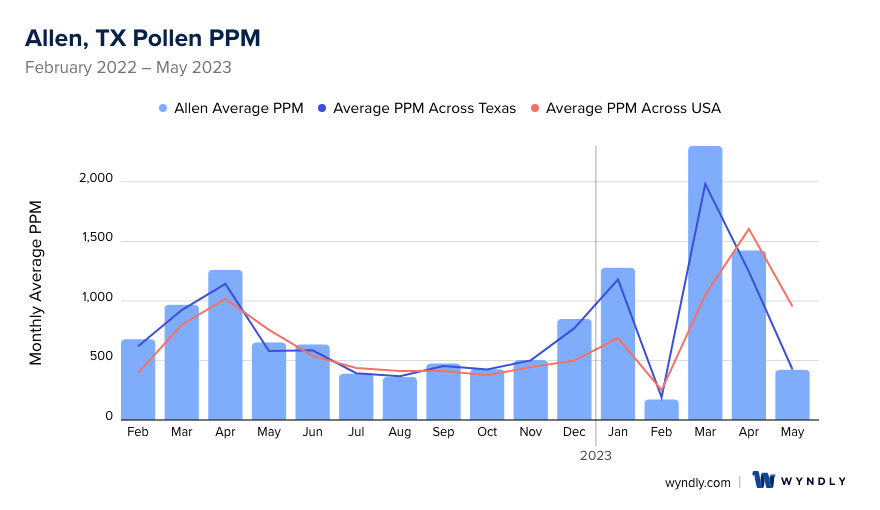
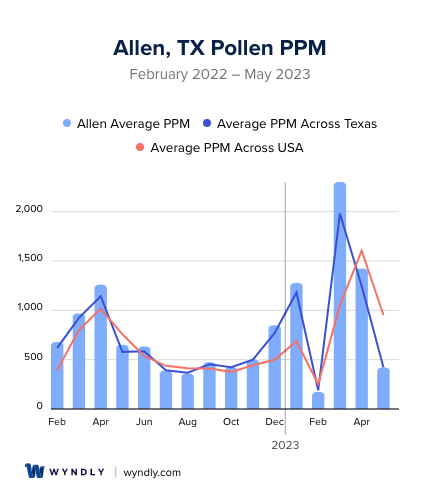
Allen, TX Pollen and Allergy Breakdown by Month
Grass
When is grass pollen highest in Allen, TX?
February has the highest grass pollen in Allen, TX with an average PPM of
When is grass pollen lowest in Allen, TX?
December has the lowest grass pollen in Allen, TX with an average PPM of
Tree
When is tree pollen highest in Allen, TX?
March has the highest tree pollen in Allen, TX with an average PPM of
When is tree pollen lowest in Allen, TX?
July has the lowest tree pollen in Allen, TX with an average PPM of
Weed
When is weed pollen highest in Allen, TX?
December has the highest weed pollen in Allen, TX with an average PPM of
When is weed pollen lowest in Allen, TX?
February has the lowest weed pollen in Allen, TX with an average PPM of
Allen, TX Pollen Monthly Breakdown by Pollen Type
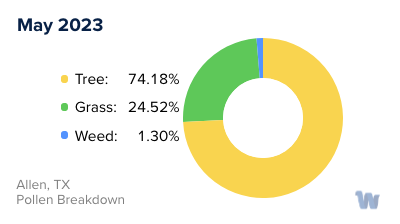
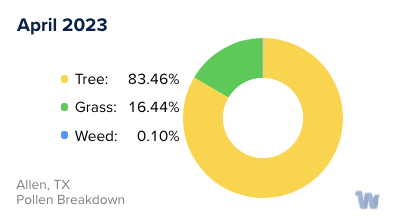
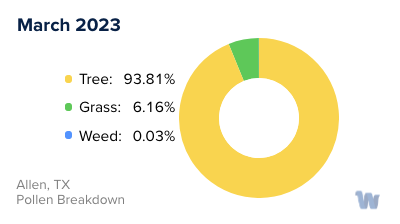
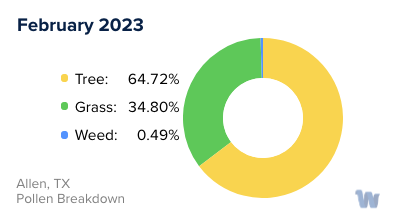
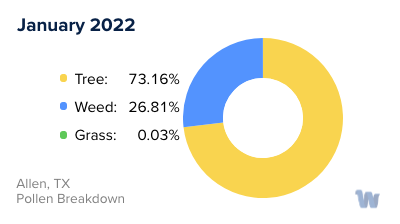
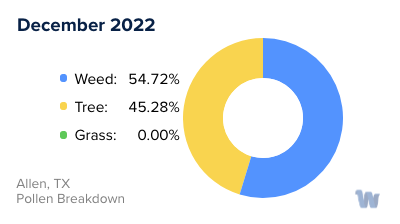
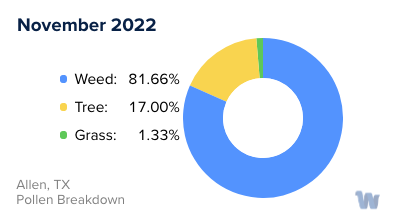
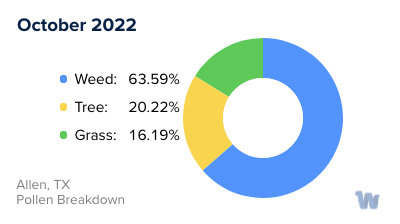
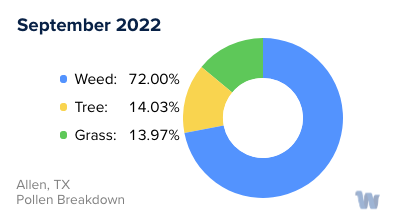
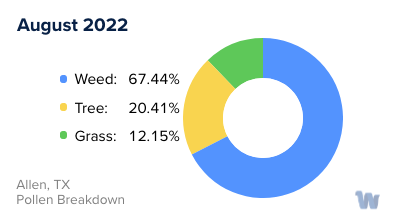
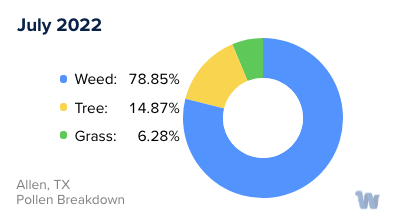
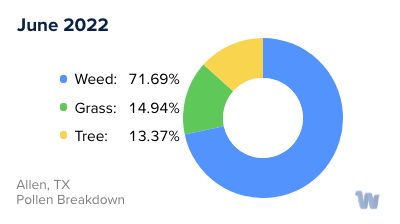
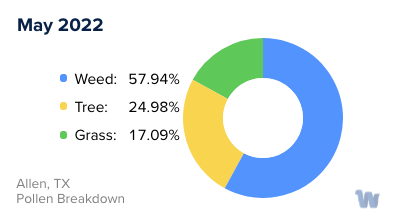
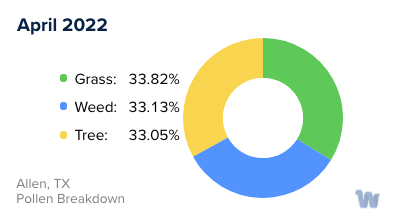
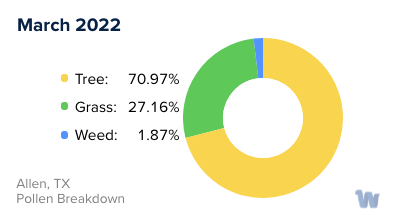
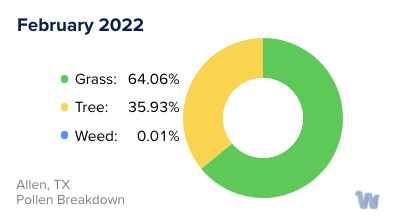
Pollen and Hay Fever in Allen, TX
In Allen, Texas, pollen allergies and hay fever follow a distinct seasonal pattern due to the variety of vegetation that contributes to pollen production.
The cycle begins from November to February, when Mountain Cedar becomes the primary source of allergens. Known for their small, light pollen that can travel hundreds of miles, Mountain Cedars are prevalent in Central Texas, making this time of year particularly challenging for those with allergies.
As the Mountain Cedar season wraps up in May, a new trio of allergens - Elm, Ash, and Mulberry - come into play from January to May. These trees produce pollen that can lead to a variety of symptoms, including sneezing, wheezing, and asthma-like symptoms.
In the heart of spring, from March to May, Oak and Pecan tree pollens join the mix, along with pollen from grasses such as Bermuda, Johnson, and Kentucky bluegrass. As grasses are abundant in the region, this time of year can be particularly irritating for anyone sensitive to grass pollen, with symptoms extending beyond the typical runny nose and watery eyes to include sore throats and additional asthma-like symptoms.
Interestingly, the hot summer months of June and July offer a brief respite. During this time, most common sources of allergies cease their pollen production, leading to a significant drop in pollen counts.
However, the respite is short-lived. In August, ragweed makes its appearance and continues to be a significant allergen until November. Ragweed, a soft-stemmed, flowering weed, is populous in the tropical and subtropical regions of the Americas and is particularly plentiful in the southwestern U.S. The ragweed season is known for causing runny noses, sneezing, itchy eyes, and at its worst, asthma flares.
As the ragweed season tapers off in November, the Mountain Cedar comes back into bloom, marking the start of another cycle of pollen allergies in Texas. Understanding this seasonal pattern can help individuals in Allen, Texas, better anticipate and manage their pollen allergies and hay fever, even though we are not discussing treatments or remedies in this context.
Keep in mind that while these are the typical patterns, individual experiences with allergies can vary based on personal sensitivity and specific weather conditions each year.

